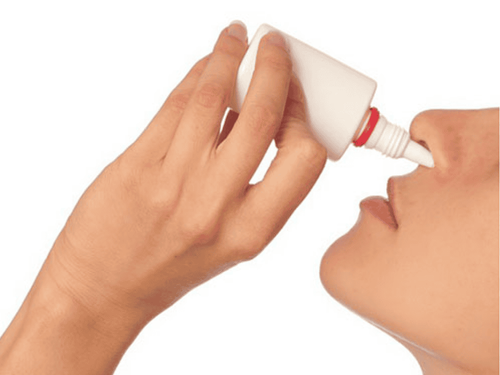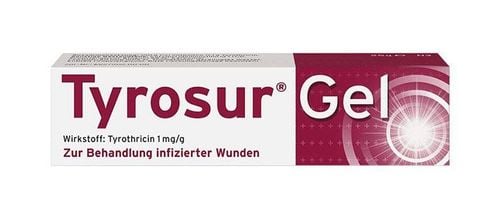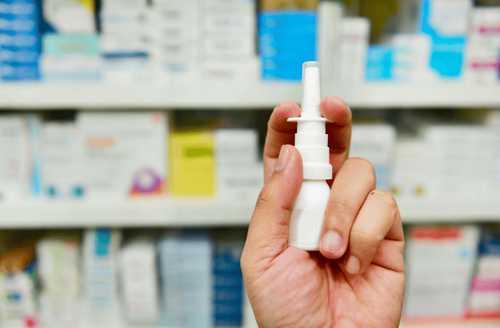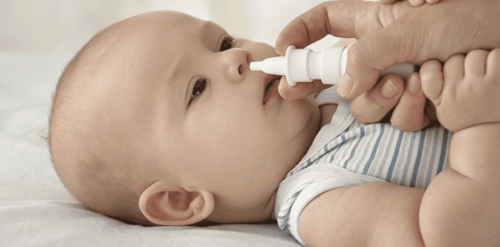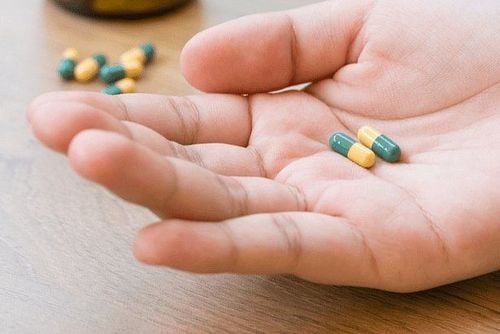This is an automatically translated article.
When suffering from stuffy nose, runny nose, rhinitis, dry nose, many parents often buy their own nasal drops and use them freely for their children. However, improper use of nasal drops for children is extremely dangerous, even affecting the heart, blood pressure and intelligence of children.
1. It is dangerous to use baby nose drops incorrectly
Runny nose, stuffy nose easily makes it difficult for children to breathe, wheeze, suck... the cause of this is due to: pharyngitis, rhinitis, bronchiolitis, bronchitis, more severe pneumonia ... When a child has rhinitis, cleaning the child's nose with nasal drops if you do not know how to do it will make it difficult for the medicine to penetrate, the treatment effect will be significantly reduced, even making the disease recur again and longer. very difficult to treat.
Besides, the improper use of baby nasal drops can cause some side effects such as:
Sore nose, dry nose, nosebleeds. Long-term use can cause sore throat. Some people are sensitive to other ingredients. part of the drug can cause nausea and vomiting, stomach irritation. Therefore, when using the above situation, you must notify a specialist.

Nhỏ mũi cho bé không đúng cách có thể gây nguy hiểm cho trẻ
2. Instructions for safe use of baby nasal drops
Should use isotonic sea salt ie physiological saline solution to clean the baby's nose. Physiological saline has the effect of moistening the nasal mucosa in case of dry and polluted air, loosening phlegm, thinning phlegm when having rhinitis. Using physiological saline to make baby nasal drops is very safe and has no side effects. Do not use adult nasal drops on children. When using nasal drops in children, they should only be used for a few days as prescribed by the doctor. Parents do not arbitrarily buy nasal drops for their children and also do not use a type of nasal drops for a long time because it will make children's nasal diseases worse. Do not arbitrarily use nasal drops containing the following ingredients: Xylometazolin, oxymetazolin, naphazoline or combining oxymetazolin with dexamethasone (a corticoid), because this is a local vasoconstrictor. When in contact with the nasal mucosa, the drug will immediately cause vasoconstriction, making the nose open, but then there is a phenomenon of nasal congestion, requiring further instillation; The nasal mucosa after many drops will be edematous, less sensitive to the drug, so it has to be instilled more, causing a vicious cycle that causes children to take high doses of drugs and become dependent on them. Therefore, in order to be safe for the baby when having a stuffy nose, parents should take the child to a specialist doctor to be examined and determined the disease, absolutely do not arbitrarily use nasal drops for the child because it easily leads to difficult consequences. measure.

Cha mẹ nên đưa trẻ đến gặp bác sĩ chuyên khoa
3. What to do when your child has a runny or stuffy nose
Should clean the nose when children have symptoms or have respiratory infections such as: runny nose, stuffy nose, cough, otitis media ... when children go home from the street.
In case the child has a runny nose, stuffy nose, it is necessary to strengthen the baby to drink a lot of water and breastfeed (for children under 6 months).
For older children, when they have a runny or thick nose, parents can guide them to practice blowing their nose, support using physiological saline with the right amount of spray to dilute the nasal discharge. Do not use your hands to cover both sides to blow your nose because it will increase pressure suddenly on the nose.
Using drugs must be prescribed by a doctor, do not arbitrarily use drugs and folk remedies; Keep children warm when it's cold outside, keep them clean because their immune system is still very weak.
Should clean the child's nose 30 minutes before eating to avoid vomiting. If the child vomits, it should be cleaned immediately because the food with gastric juice will stick on the nose, which is the cause of persistent rhinitis in children.
When cleaning the nose, the child should be placed on his side. It is best to choose a type of sea salt water that, when pressed continuously on the nozzle, sprays continuously. After spraying the child's nose for about 5 minutes, parents use a nasal aspirator to suck out the mucus in the child's nostrils before feeding the child. Absolutely do not use your mouth to suck your child's nose because it will easily spread more germs to the child. For older children, you can let the child sit and tilt his head to one side to spray the nasal spray. Then instruct the child to blow his nose.
If you don't use a spray bottle, you can replace it by using 0.9% physiological saline drops into your child's nose according to the above steps, then blow out the nose. Note when the child blows his nose, should instruct the child to use one finger to cover one nostril, blow the other nostril and then do the other nostril. Absolutely do not let children blow their nose strongly on both sides because this movement suddenly increases pressure in the ear, easily causing eardrum rupture.
It is also possible to use a soft, tough tissue as a deep wick placed in the child's nasal cavity to wet the nasal secretions, then remove and place a clean wick. Repeat these steps until the nose is clear.

Khi vệ sinh mũi, nên đặt trẻ nằm nghiêng sang một bên.
Vinmec International General Hospital is one of the hospitals that not only ensures professional quality with a team of leading medical professionals, modern equipment and technology, but also stands out for its examination and consultation services. comprehensive and professional medical consultation and treatment; civilized, polite, safe and sterile medical examination and treatment space. Customers who choose to perform services here can be completely assured of the results. In addition, customers will be examined with a specialist to determine the risk of disease and have a scientific treatment direction.
Customers can directly go to Vinmec Health system nationwide to visit or contact the hotline here for support.
MORE
What to know about Seretide Asthma Spray Is Allergic Rhinitis Contagious? Diagnostic tests for allergic rhinitis





